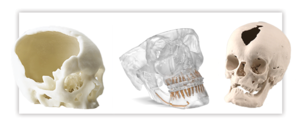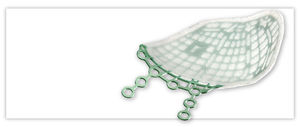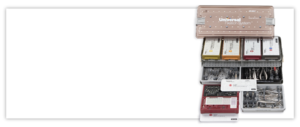
SMARTLock Hybrid MMF - clinical evidence
The problem:
Each of the two widely accepted standards of care for Maxillomandibular fixation, arch bars and MMF screws, have distinct pros and cons as referenced in the medical literature. Arch Bars have been considered the gold standard in attaining pre-injury occlusion, however MMF screws are also frequently used for MMF reduction.
Below is a summary the shortcomings of each treatment method as referenced in the available literature.
Current treatment:
| Arch bars |
|---|
Drawbacks:
|
| MMF screws |
| Drawbacks: |
Additional clinical evidence:
BACKGROUND:
PURPOSE:
MATERIALS AND METHODS:
RESULTS:
CONCLUSIONS:
Mandibulo-maxillary fixation (MMF) screws are inserted into the bony base of both jaws in the process of fracture realignment and immobilisation. The screw heads act as anchor points to fasten wire loops or rubber bands connecting the mandible to the maxilla. Traditional interdental chain-linked wiring or arch bar techniques provide the anchorage by attached cleats, hooks, or eyelets. In comparison to these tooth-borne appliances MMF screws facilitate and shorten the way to achieve intermaxillary fixation considerably. In addition, MMF screws help to reduce the hazards of glove perforation and wire stick injuries. On the downside, MMF screws are attributed with the risk of tooth root damage and a lack of versatility beyond the pure maintenance of occlusion such as stabilizing loose teeth or splinting fragments of the alveolar process. The surgical technique of MMF screws as well as the pros and cons of the clinical application are reviewed. The adequate screw placement to prevent serious tooth root injuries is still an issue to rethink and modify conceptual guidelines
PURPOSE:
The purpose of this prospective randomized study was to assess whether uncomplicated mandible fractures could be treated successfully in an open or closed fashion using maxillomandibular fixation (MMF) screws.
MATERIALS AND METHODS:
This was a prospective institutional review board-approved study involving 20 adult patients who presented to the university emergency department or oral and maxillofacial surgical clinic with uncomplicated mandible fractures. Patients who met the exclusion criteria consented to enter the study in the open reduction internal fixation (ORIF) or the closed (MMF) study group. Six to 8 MMF screws were used to obtain intermaxillary fixation (IMF) in the 2 groups. Screw failure was documented. All screws were removed at 5 to 6 weeks postoperatively. Insertional torque (IT) was measured at time of screw placement to assess primary stability. Clinical and photographic documentation was performed to assess fracture healing, occlusion, and gingival health. Ten-centimeter visual analog scales were used to assess patient-centered outcomes. Cone-beam computed tomography was performed to assess the long-term effects on the periodontium and roots. A cost comparison was performed to determine whether the use of screws was cost effective compared with arch bars.
RESULTS:
Fifteen men and 5 women (mean age, 25.2 yr) entered the study. All patients displayed adequate fracture healing based on clinical examination. All patients had acceptable occlusion at 5 to 6 weeks postoperatively. Total screw failure was 27 of 106 screws (25.5%). Forty percent of screws placed in the MMF group failed compared with only 6% in the ORIF group. Gingival health scores were favorable. Factors that had a significant effect on screw failure included a lower IT (P = .002), use in closed (MMF) treatment (P < .001), and use in the posterior jaw (P = .012). Minimal pain was associated with the MMF screws and pre-existing occlusion was re-established based on patients' subjective responses. The MMF group reported a statistically significant lower quality of life (P < .001) compared with the ORIF group. There was only 1 screw site that had a facial cortical bone defect noted at 6-month follow-up CBCT examination. There were no discernible long-term root defects. Cost analysis showed that the use of MMF screws saved around $600 per patient in operating room usage cost alone compared with the estimated use of arch bars.
CONCLUSIONS:
Uncomplicated mandible fractures were successfully treated using MMF screws in open and closed treatments. However, the utility in closed treatment was decreased because of significant screw failure and patient noncompliance. The screws were well tolerated by the patients. There was minimal long-term damage to the periodontium and dental roots. The cost of screws was more than offset by time savings.




